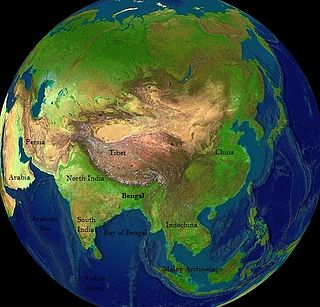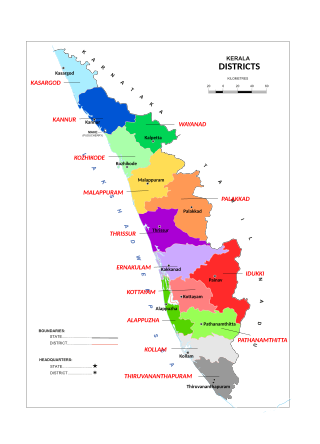Related Research Articles

Bengal or endonym Bangla is a historical geographical, ethnolinguistic and cultural term referring to a region in the eastern part of the Indian subcontinent at the apex of the Bay of Bengal. The region of Bengal proper is divided between modern-day Bangladesh and the Indian state of West Bengal. The Indian states of Assam, Jharkhand, Bihar, Chhattishgarh and Tripura as well as the union territory of Andaman and Nicobar islands have a sizeable Bengali population. A large Bengali diaspora exists across the world. Bengali is the sixth-most spoken language in the world.

Languages spoken in the Republic of India belong to several language families, the major ones being the Indo-Aryan languages spoken by 78.05% of Indians and the Dravidian languages spoken by 19.64% of Indians; both families together are sometimes known as Indic languages. Languages spoken by the remaining 2.31% of the population belong to the Austroasiatic, Sino–Tibetan, Tai–Kadai, and a few other minor language families and isolates. According to the People's Linguistic Survey of India, India has the second highest number of languages (780), after Papua New Guinea (840). Ethnologue lists a lower number of 456.

Sonitpur district [Pron: ˌsə(ʊ)nɪtˈpʊə or ˌʃə(ʊ)nɪtˈpʊə] is an administrative district in the state of Assam in India. The district headquarters is located at Tezpur.

Bengalis, also rendered as endonym Bangalee, are an Indo-Aryan ethnic group originating from and culturally affiliated with the Bengal region of South Asia. The current population is divided between the sovereign country Bangladesh and the Indian states of West Bengal and Tripura, Barak Valley, Andaman and Nicobar Islands, Jharkhand and part of Meghalaya and Manipur. Most speak Bengali, a language from the Indo-Aryan language family. Sub-section 2 of Article 6 of the Constitution of Bangladesh states, "The people of Bangladesh shall be known as Bengalis as a nation and as Bangladeshis as citizens."
East Bengali Refugees are people who left East Bengal following the Partition of Bengal, which was part of the Independence of India and Pakistan in 1947. An overwhelming majority of these refugees and immigrants were Bengali Hindus. During the Bangladesh liberation war with West Pakistan, an estimated ten million people of East Pakistan fled the country and took refuge in India particularly in the Indian states of West Bengal and Indian North East region, especially Tripura and Assam.

The Barak Valley is the southernmost region and administrative division of the Indian state of Assam. It is named after the Barak river. The Barak valley consists of three administrative districts of Assam namely - Cachar, Karimganj, and Hailakandi. The main and largest city is Silchar, which seats the headquarter of Cachar district and also serves as administrative divisional office of Barak valley division. The valley is bordered by Mizoram and Tripura to the south, Bangladesh and Meghalaya to the west and Manipur to the east respectively. Once North Cachar Hills was a part of Cachar district which became a subdivision in 1951 and eventually a separate district. On 1 July 1983, Karimganj district was curved out from the eponymous subdivision of Cachar district. In 1989 the subdivision of Hailakandi was upgraded into Hailakandi district.

The following outline is provided as an overview of, and topical guide to, India:

Bengali Hindus are an ethnoreligious population who make up the majority in the Indian states of West Bengal, Tripura, Andaman and Nicobar Islands, Jharkhand, and Assam's Barak Valley region. In Bangladesh, they form the largest minority. They are adherents of Hinduism and are native to the Bengal region in the eastern part of the Indian subcontinent. Comprising about one-third of the global Bengali population, they are the second-largest ethnic group among Hindus after Hindustani Hindus. Bengali Hindus speak Bengali, which belongs to the Indo-Aryan language family and adhere to Shaktism or Vaishnavism of their native religion Hinduism with some regional deities. There are significant numbers of Bengali-speaking Hindus in different Indian states. According to the census in 1881, 12.81 per cent of Bengali Hindus belonged to the three upper castes while the rest belonged to the Shudra and Dalit castes.

Migrant labourers in Kerala, India's southernmost state, are a significant economic force in the state; there were around 2.5 million internal migrants in Kerala according to a 2013 study by the Gulati Institute of Finance and Taxation. Every year, the migrant worker population in Kerala increases by 2.35 lakh (235,000) people. The study, based on long-distance trains terminating in Kerala, does not cover migrants from the neighbouring states who use other modes of transport. Assuming that the estimation is rigorous and extrapolating it, taking into account the net annual addition, possible growth in migration rate, as well as accounting for the migration from the neighbouring states, Kerala is likely to have 5 to 5.5 million inter-state migrant workers in 2020. Despite their importance and despite many of them praising the state for its welfare schemes and environment, they are often ignored in comparison and suffer from comparatively poor living conditions.
The Bengali Hindu diaspora is the worldwide population of the Bengali Hindus of Indian and Bangladeshi origin.

Islam is the second largest and fastest-growing religion in Assam. The Muslim population was approximately 10.68 million, constituting over 34.22% of the total population of the state as of the 2011 census, giving Assam, the second-largest Muslim percentage in the country after Jammu and Kashmir (state). After Jammu and Kashmir became Union Territory, Assam became the state with largest Muslim percentage in the country. Islam reached the region in the 13th century and Muslims are a majority in almost eleven districts of Assam and highly concentrated in four districts. In 2021, estimations have predicted that the Muslim population in the state has reached 40%, numbering 14 million, out of total population of 35 million.
An illegal immigrant in India is a foreigner who has entered India either without valid documents or who initially had a valid document, but has overstayed beyond the permitted time, as per the general provisions of the Citizenship Act as amended in 2003. Such persons are not eligible for citizenship by registration or naturalisation. They are also liable to be imprisoned for 2–8 years and fined.
The Assamese Language Movement refers to a series of political activities demanding the recognition of the Assamese language as the only sole official language and medium of instruction in the educational institutions of Assam, India.
The Bengali Language Movement is a campaign to preserve Bengali language and Bengalis culture and to oppose anti-Bengali sentiment in India. The movement was started in Manbhum in 1940, ahead of the Partition of India which allocated eastern Bengal to the new nation of Pakistan and led to the relocation of many Bengali communities. In 1947 British India bifurcated into India and Pakistan. The population of the eastern part of Bengal was majority Muslim, and was incorporated into Pakistan. Bengali Hindus in this eastern region migrated to India, principally settling in West Bengal, Chhattisgarh, Dandakaranya and Odisha, Maharashtra, Karnataka. The Movement remains prominent in Assam, Jharkhand, Bihar, Chhattisgarh and Karnataka.
The Miya people, alternatively identified as Na-Asamiya by themselves, denote the progeny of Bengali Muslim migrants originating from the contemporary Mymensingh, Rangpur, and Rajshahi Divisions. These individuals established residence in the Brahmaputra Valley during the 20th century, coinciding with the period of British colonial rule in Assam. The migration of the Miya people was actively promoted by the Colonial British Government from the Bengal Province, spanning the years 1757 to 1942. This migratory trend persisted until the year 1947. Presently, the term "Miya" is employed as a discriminatory label.

Bengali Hindus are the second-largest Hindu community just after Assamese Hindus in Assam. As per as estimation research, around 6–7.5 million Bengali Hindus live in Assam as of 2011, majority of whom live in Barak Valley and a significant population also resides in Brahmaputra Valley. The Bengali Hindus are mostly native to the Barak Valley region. Assam host the second-largest Bengali Hindu population in India after West Bengal.
Discrimination against Bengalis in India comprises negative attitudes and views on Bengalis in India. Though Bengalis have lived in different parts of India for centuries, they are subject to widespread discrimination. This can be either by any other community or in any particular place, due to reasons like inhabitation, discriminating sentiments, political reasons, Government actions, anti-Bangladeshi sentiment etc. The discriminative condition of Bengalis can be traced from Khoirabari massacre, Nellie massacre, Silapathar massacre, North Kamrup massacre, Goreswar massacre, Bongal Kheda etc. This has led to emergence of Bengali sub-nationalism in India as a form of protest and formation of many pro-Bengali organisations in India.
The population of Assam consist of tribal ethnic groups and linguistic groups such as Assamese, Bengali, Hindi speakers, Nepali and Odia speakers.
References
- ↑ "Report of the Commissioner for linguistic minorities: 50th report (July 2012 to June 2013)" (PDF). Commissioner for Linguistic Minorities, Ministry of Minority Affairs, Government of India. Archived from the original (PDF) on 8 July 2016. Retrieved 13 November 2017.
- ↑ — "What census data reveals about use of Indian languages". Deccan Herald . Retrieved 2023-11-16.
— "Hindi Added 100Mn Speakers In A Decade; Kashmiri 2nd Fast Growing Language". 2018-06-28. Retrieved 2023-11-16.
— "Hindi fastest growing language in India, finds 100 million new speakers".
— "Hindi grew rapidly in non-Hindi states even without official mandate". India Today . Retrieved 2023-11-16. - ↑ "Distribution of the 22 Scheduled Languages – India, States & Union Territories – 2011 Census" (PDF). Government of India .
- ↑ "Census of India - Distribution of 10,000 persons by language – India, States and Union Territories-2011". Government of India.
- 1 2 3 "Census of India - Distribution of 10,000 persons by language – India, States and Union Territories-2001".
- ↑ "Distribution of the 22 Scheduled Languages – India, States & Union Territories – 2001 Census".
- ↑ "Opinion: Why a United Bengal in 1947 wouldn't have worked out".
- ↑ "C-16 POPULATION BY MOTHER TONGUE". Registrar General and Census Commissioner of India . Archived from the original (XLSX) on 2018-07-08. Retrieved 2023-11-04.
- ↑ Dikshit, K. R.; Dikshit, Jutta K. (21 October 2013). North-East India: Land, People and Economy. Springer Science & Business Media. p. 352. ISBN 978-94-007-7055-3.
- ↑ "BJP eyes 2.2 m Bengali Hindus in Tripura quest". The Pioneer. 14 May 2017.
- ↑ "In Assam, Rising Share of Bengali Speakers Doesn t Necessarily Point to Infiltration".
- ↑ Bhattacharya, D. P. "CAA protests in Assam: Why it is different from the rest of the country". The Economic Times.
- 1 2 "In Assam, campaign urging Bengali Muslims not to list Assamese as mother tongue has sparked protests". 9 June 2019.
- ↑ Chubbra K. M. L, Assam Challenge, Konark Publishers Pvt. Ltd, Delhi, 1992.
- ↑ "Insurgency in Assam: The Demographic Dimensions".
- ↑ "Census of India Website : Office of the Registrar General & Census Commissioner, India"
- ↑ "C-16 Population By Mother Tongue". censusindia.gov.in. Retrieved 19 February 2021.
- ↑ Andaman, Team Explore. "Andaman Nicobar population - a description". Population mix of Andaman and Nicobar. Retrieved 2021-04-22.
- ↑ Singh, Kautilya. "What's this Bengali doing in Uttarakhand poll pitch?". The Economic Times. Retrieved 2021-08-06.
- ↑ Bibin Babu (May 3, 2016). "Perumbavoor: A mini North India in Kerala | Kochi News - Times of India". The Times of India. Retrieved 2021-08-06.
- ↑ Menon, Sreelatha (2011-07-27). "Kerala, a 'Dubai' for Bengali migrants". Business Standard India. Retrieved 2021-08-06.
- ↑ "NCST to ask Chhattisgarh to probe if refugee resettlement led to demographic changes in tribal areas". The Hindu. PTI. 2020-01-19. ISSN 0971-751X . Retrieved 2021-08-06.
- ↑ Bagchi, Suvojit (2018-11-09). "Congress parachutes Bengali leaders to campaign in southern Chhattisgarh". The Hindu. ISSN 0971-751X . Retrieved 2021-08-06.